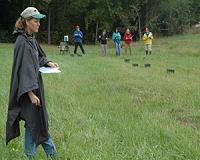| . |  |
. |
Washington DC (SPX) Aug 04, 2010 In this time of global change, understanding the basics of animal behavior and environmental interactions is just as important as predicting and planning for widespread impacts. Ecological scientists will assess the fundamentals of animal behavior-such as plant toxin detection in bushbaby foraging-and current adaptations to global change-like defense mechanisms of native lizards to red imported fire ant attacks and the role of antioxidants and radiation in barn swallow reproduction-at the Ecological Society of America's (ESA) 95th Annual Meeting in Pittsburgh from August 1-6, 2010. Below is a sampling of some of the research to be presented on animal behavior:
Plant toxin detection in bushbaby foraging The bushbabies chose between a food patch hidden in a tree that contained various low concentrations of the plant toxin cineole, and a non-toxic food patch located near fresh leopard scat-indicating the nearby presence of predators. According to research to be presented at ESA's Annual Meeting, the bushbabies' behavior indicated a foraging "tipping point." That is, to the bushbabies, the danger of eating food with five percent cineole was equivalent to the perceived risk of leopards on the ground. The contributed oral session "Bushbaby foraging ecology: walking the tightrope between predation risk and plant toxins" led by Clare McArthur, University of Sydney, will be held Thursday, August 5, 2010 at 3:40 pm.
Other sessions on foraging and feeding include:
Lizard defense from invasive fire ants For native fence lizards, Sceloporus undulatus, the options are to adapt and co-exist with these ants or to run the risk of lethal consequences. Tracy Langkilde from Pennsylvania State University found elevated levels of stress hormones, called glucocorticoids, in lizard populations inhabiting areas near large numbers of fire ants. In other words, lizards exposed to repeated attacks by fire ants had higher stress levels and a heightened awareness of fire ant threats. As Langkilde explains, "this suggests that, rather than being a cause for concern, elevated levels of physiological stress within invaded [lizard] populations may be playing an important role in driving [adaptations] to novel threats." The contributed oral session "Stress and invasion: factors influencing the escape behavior of native fence lizards in response to introduced fire ants" by Tracy Langkilde, Pennsylvania State University, will be held Monday, August 2, 2010 at 4:00 pm.
Other sessions on species interactions include:
Antioxidants defend barn swallow sperm from radiation Naturally, mutations that prevent sperm from effectively swimming could lead to population declines. Andrea Bonisoli Alquati from the University of South Carolina and colleagues analyzed the effects of radiation, namely oxidative damage, in barn swallow populations inhabiting areas near Chernobyl. As the researchers will discuss at ESA's Annual Meeting, the findings suggest "a possible radioprotective role for antioxidants in free-ranging animals exposed to the fallout from Chernobyl." The contributed oral session "Antioxidant defenses and sperm swimming behavior in barn swallows from Chernobyl," led by Andrea Bonisoli Alquati, University of South Carolina, will be held Monday, August 2, 2010 at 2:10 pm.
Other sessions on mate selection and reproduction include:
Share This Article With Planet Earth
Related Links Ecological Society of America Darwin Today At TerraDaily.com
 'Ribbit Radio' Shows Frog Population Estimates Are Likely Flawed
'Ribbit Radio' Shows Frog Population Estimates Are Likely FlawedRaleigh NC (SPX) Aug 03, 2010 Scientists track amphibian populations because these animals are sensitive to changes in their environment and can serve as "canaries in the coal mine" to give researchers early warnings about pollution or other ecological problems. But new research from North Carolina State University shows that data from the largest amphibian monitoring program in the country may have flaws that, if unco ... read more |
|
| The content herein, unless otherwise known to be public domain, are Copyright 1995-2010 - SpaceDaily. AFP and UPI Wire Stories are copyright Agence France-Presse and United Press International. ESA Portal Reports are copyright European Space Agency. All NASA sourced material is public domain. Additional copyrights may apply in whole or part to other bona fide parties. Advertising does not imply endorsement,agreement or approval of any opinions, statements or information provided by SpaceDaily on any Web page published or hosted by SpaceDaily. Privacy Statement |